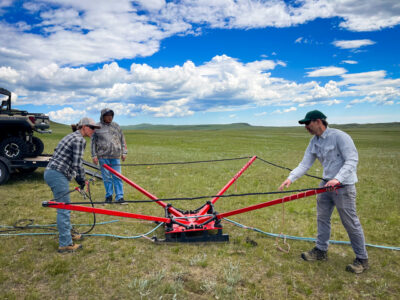Groundwater monitoring network being established
By Lethbridge Herald on July 23, 2024.
 Photo courtesy of Living Lakes Canada -
Geo scanning technology is used at the Piikani Nation earlier this June.
Photo courtesy of Living Lakes Canada -
Geo scanning technology is used at the Piikani Nation earlier this June.Al Beeber – LETHBRIDGE HERALD – abeeber@lethbridgeherald.com
A two-year pilot project monitoring groundwater in the Oldman River watershed has begun.
The intention of the project is to enhance monitoring of groundwater and gain knowledge of aquifers to promote more water security.
The Southwest Alberta Groundwater Project is led by the Oldman Watershed Council and Living Lakes Canada.
In partnership with the Piikani Nation Lands Department, the project will use advanced geo-scanning technology consultations with communities and partnerships with owners of private wells to build a groundwater monitoring network.
A two-hour free public engagement workshop will be staged online Thursday from 1:30 to 3:30 p.m. with experts from the University of Calgary and the Alberta government.
Interested attendees can register at http://www.eventbrite.ca by searching for Southwest Alberta Groundwater Project Launch.
At the meeting, attendees will hear what is known about the state of groundwater knowledge in this province and learn details about the project.
In an interview this week, project lead Maggie Finkle-Aucoin said the plan is to expand the project throughout Alberta.
The project is in its infancy with many engagement sessions being planned as it progresses.
More than 600,000 rural Albertans depend on groundwater for their drinking water, said Finkle-Aucoin. This doesn’t include other activities that rely on groundwater including domestic use or agricultural and industrial needs.
“With surface water drying up, groundwater is going to become an increasingly important topic and we want to make sure that we’re contributing to data whenever it comes to the quantity of that water so that management strategies can be put in place while there’s still time to do so responsibly and not after the fact when we start to see groundwater drying up,” Finkle-Aucoin said.
Thursday’s event will be the “hard launch” of the project to the public, she said.
“We’re going to be doing some groundwater monitoring through the whole Oldman watershed,” with three volunteer observation wells that will be selected.
The site selection process for the observation wells will be decided using a couple of methods, including from a scientific lens. This will take into consideration monitoring that is already being done and where there may be gaps in the monitoring.
Community concerns and priorities will also be considered.
The science along with community concerns will be used to influence site selection for the groundwater monitoring wells, Finkle-Aucoin added.
There are declines being seen “across the board” with observation wells showing the lowest levels ever recorded, she said.
“We know we’re kind of in a concern area but I think what we really want to focus in on is filling those data gaps and getting a better understanding of where is the groundwater, what is there, what is available and then working with other ongoing initiatives that are also looking at groundwater quality as well,” she said.
She said the groups are looking at how their initiatives can work side-by-side and increase knowledge about groundwater in general.
The Oldman Watershed is being considered the pilot area for this particular initiative in Alberta.
Living Lakes Canada is hoping to expand into the Bow River water basin after this project is finished. And it wants to look at the big picture province-wide, as well.
A few different technology processes will be utilized. One assessment will look at data already available on aquifers and learn where vulnerabilities exist which will play into the scientific part of the site selection process.
An engineering firm has access to a piece of equipment that collects subsurface information that can penetrate almost up to 100 metres below the surface. It is used to look at subsurface material and discover areas where aquifer suitable geology would most likely be found.
The project is based on work being done in B.C.’s Columbian Basin by LLC which has increased groundwater monitoring there by more than 425 per cent, said Finkle-Aucoin.
Because of the success of that program, the Oldman Watershed council reached out to have conversations about concerns that are happening in Alberta and asked if Living Lakes Canada would be willing to work with them.
From there, the concept behind southern Alberta groundwater monitoring network was born, she said.
“We’re really excited to move forward and we’re ready to hopefully make some really impactful, tangible changes to our community by implementing these wells and having an understanding of what’s happening with groundwater,” added Finkle-Aucoin.
29-28


